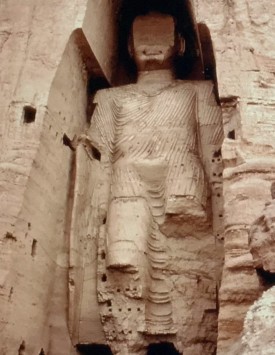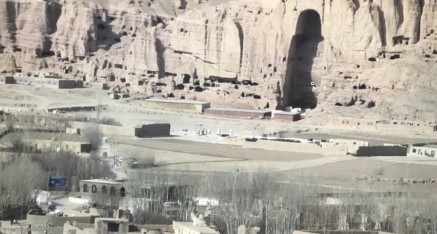Although most would agree that we are currently living in degenerate times, oft referred to as the “Dharma-ending Age,” there are other considerations given in the sutras that offer great hope. First, it would appear that the most dire of predictions on the time that the dharma would remain applied to India, the land of its earthly origins. For example, The Sutra of the Golden Age states that the dharma will only exist in its pure form for 500 years after the passing of Shakyamuni Buddha. After that the dharma will exist as a shadow of its real self for another 1,500 years. Other sutras refer to a period of 1,000-2,000 years as well. It is true that the Buddhism lasted in India for less than 2,000 years. However, Buddhism was exported to other countries where it took root and flourished for much longer. In China it lasted for many centuries and in Tibet it flourished for over a thousand years. It is still the state religion in many countries in south-east Asia. However, there is good evidence that some of the original power and effectiveness of the teachings have been lost over time and in many cases, only a “shadow” of what Shakyamuni Buddha taught remains.
Also, as Shakyamuni Buddha tells Subhuti in the Tibetan version of the Diamond-Cutter Sutra, when the dharma ending days come, great Bodhisattvas who possess morality, fine qualities, and wisdom will incarnate. In India there were the Six Jewels (Great Dharma Kings–Nagarjuna, Aryadeva, Asanga, Vasubandhu, Dignaga, and Dharmakirti), Shantideva and others who developed the texts that are considered the core classic commentaries today. In Tibet there were the great Dharma Kings: Padmasambhava, Marpa, Sakya Pandita, Dolpopa, Longchenpa, Lady Niguma, Tsongkhapa, Tangtong Gyalpo, Taranatha, Jigme Lingpa and others.
For over 500 years between the coming of Master Padmasambhava in the 8th century until Master Tsongkhapa came in the 14th century, the great or high dharmas were available in Tibet and many people easily achieved enlightenment in one lifetime. This was because the tantric teachings were freely taught—even to many who did not have the discipline or qualifications to receive them. By the 14th century, Master Tsongkhapa (1357-1419) had a different situation. Because the tantric teachings had been so liberally transmitted and the discipline required for proper transmission had been lax, there were many false rinpoches and lamas and much of what was being practiced as dharma was not correct. Master Tsongkapa’s mission was to restore the discipline and bring order out of the chaos that had developed from the other transmissions to the Nyingma, Jonang, Kagyu, and Sakya sects. It is not that the other transmissions were wrong. It is just that because of the lack of discipline and the transmission of dharma to those who were not qualified to receive it, the dharma became corrupted and many of the lineages were filled with false rinpoches and false dharma, as is true today. Master Tsongkapa, a great scholar and disciplinarian, dutifully set out to correct the dharma and restore order to monastic practice. To set an example for his monks, Master Tsongkhapa, himself a monk, did not practice the higher tantric dharmas. As a result he was not able to obtain the rainbow body or become a Buddha while alive. He only obtained Buddhahood in the bardo. Also he did not transmit these higher dharmas to his disciples. The Geluk sect itself does not have these higher tantric practices. The Gelukas cannot obtain enlightenment in one lifetime from the practice of their own teachings.
The systems that evolved for classifying these periods or ages of the dharma are generally as follows:
Golden Age or Age of True Dharma(500-1,000 years): Practitioners are of a high capacity and the teachings are transmitted intact, so that many achieve the goal of liberation. During this period the teaching is vigorous, people are capable of comprehending it AND putting it into practice and many attain enlightenment under their own power.
Age of Counterfeit or Semblance Dharma; zobo in Japanese (500-1,000 years): Practitioners have lower capacities, shorter life-spans, and the teachings are transmitted imperfectly so that only a semblance of the true dharma remains, with attainment of the goal being rare. Only a few people of great intelligence are able to grasp the doctrine correctly and obtain enlightenment.
Dharma-Ending Age or Age of the Final Dharma, mo-fa in Chinese or mappo in Japanese (500-1,000 years): Practitioners are of a low capacity, the dharma cannot be transmitted correctly, and the world is beset by so many problems that is not possible to practice. It was in response to the perception that we had entered this period that the new modes of practice arose such as the Pure Land Sect that relies on the power of an already-enlightened Buddha or the Nichiren Sect which relies on chanting the Lotus Sutra.
It is also stated that the method for accounting for these periods are different in the sutras and in the tantras. The Kalachakra tantra, for example, has the end of the vajryana coming in 4224 C.E. and the mahayana in 4120 C.E.
By any of the methods of accounting and by just observing the world around us, it can be seen that we have entered the “Dharma-Ending Age.” However, the Buddha, having foreseen this dark age, provided for teachings that were appropriate for the different ages and predicted that great Holy Ones would incarnate at appropriate times and places to revitalize and teach the dharma that was appropriate for that period of time and place. It is because of these conditions that His Holiness Dorje Chang Buddha III came to this world to demonstrate that the true Buddha-dharma does still exist and to offer us a “Quick Path” to liberation. When talking about H.H. Dorje Chang Buddha III, Penor Rinpoche, the third leader of the Nyingma Sect, told Zhaxi Zhuoma Rinpoche that “because this is the Dharma-Ending Age, it is good that such a high being has incarnated.” H.H. Penor Rinpoche was one of the leaders of Buddhism who recognized H.H. Dorje Chang Buddha III.


